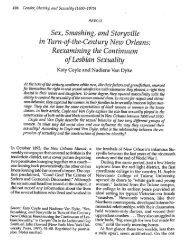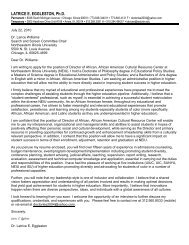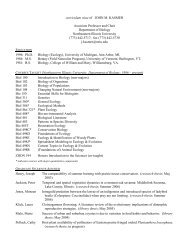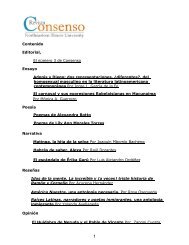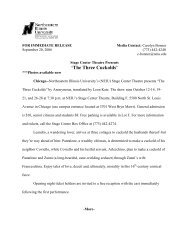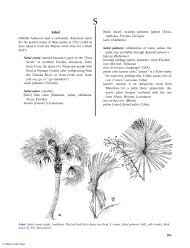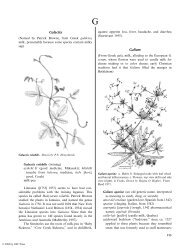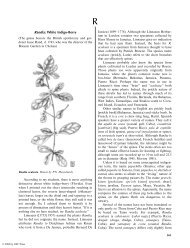Herba Cana - Northeastern Illinois University
Herba Cana - Northeastern Illinois University
Herba Cana - Northeastern Illinois University
Create successful ePaper yourself
Turn your PDF publications into a flip-book with our unique Google optimized e-Paper software.
© 2004 by CRC Press<br />
The Ethnobotany 543<br />
iti alikchi [italikchi] (iti, tree, alikchi, doctor,<br />
Choctaw; an axiom of the tribe was never to<br />
kill a cherry tree; considered the best medicine<br />
for young girls)<br />
kwah noon:’ sdeʔee (Cherokee)<br />
mountain cherry<br />
[sand, sandhill, Indian] plum<br />
stiiñki (Biloxi)<br />
takkonlushi [takkon lushi] (takkon, originally<br />
plum, now peach, oshi, small, Choctaw); takkoosàwwa<br />
[takkosàwwa, takkosáwwa] (takkola,<br />
plum, sawwa, small, Chickasaw); takoloshi’<br />
(Chickasaw); takoloshi’ imilhlha’ (takoloshi’,<br />
plum, imiɬɬa’, wild, Chickasaw)<br />
Prunus caroliniana (from Carolina)<br />
[American, Carolina] cherry or laurel-cherry [laurelcherry]<br />
(‘‘laurel-cherry’’ was in use by 1789; the<br />
modifiers distinguish the New World from the<br />
Asian species)<br />
cherry laurel (in English by 1664; the namesake,<br />
Prunus laurocerasus was introduced into Europe<br />
in 1576 from Turkey, according to Linnaeus; Old<br />
World plants were used to make ‘‘cherry-laurel<br />
water,’’ a watery solution of the volatile oils from<br />
the plant containing prussic acid)<br />
ittokchakkosi (itto, tree, okchakko, blue-green, osi,<br />
small, Alabama)<br />
mock-[wild-]orange<br />
wild-peach<br />
Prunus geniculata (referring to nodes, sometimes<br />
resembling knees, the stems being zigzag)<br />
[Harper’s, scrub] plum<br />
Prunus myrtifolia (with leaves like myrtle, Myrtus<br />
communis)<br />
almendrillo [almendrito] (little almond, Cuba,<br />
Dominican Republic, Puerto Rico); almendro<br />
(almond, Venezuela); amandier à petite feuilles<br />
(little-leaf almond, Haiti); amandier des bois<br />
(Martinique)<br />
ants-wood (Jamaica)<br />
cassada-wood [wild cassada, wild cassava] (comparing<br />
it with ‘‘cassava’’ [Manihot], Jamaica)<br />
cuajaní hembra (female cuajaní; a river in the<br />
Dominican Republic has the Taino name cuaja,<br />
Cuba); cuajanincillo (little cuajaní, Cuba)<br />
durasnero de monte (wild peach, Brazil)<br />
la mandit [le mongier] (the almond, Haiti)<br />
marmelo bravo [do matto] (wild quince, Cydonia<br />
oblonga, Brazil); membrillo [membrillito] (little<br />
quince, Dominican Republic)<br />
myrtle laurel-cherry (USA); West Indian [laurel]<br />
cherry (USA, Bahamas)<br />
noyou (almond, Guadeloupe; a name also applied<br />
to Merremia dissecta)<br />
palo de hacha (ax tree, Dominican Republic)<br />
virarú (maybe from virar, leaning to one side,<br />
Brazil)<br />
warimiaballi (warimia, isTapirira guianensis in the<br />
Anacardiaceae, balli, resembling, Arawak, Suriname)<br />
yaya boba (crazy yaya, the word yaya is surely<br />
Taino as it appears in several plant names,<br />
Dominican Republic)<br />
Prunus serotina (late-ripening)<br />
aguasique (Pima Bajo)<br />
capulín [capolín, capulí] (Náhuatl, Texas, Sonora<br />
to Veracruz and Chiapas, Guatemala)<br />
cereso [cerezo, cereza] (Chiapas, Guatemala);<br />
cerises d’atomne (autumn cherry, Quebec)<br />
[cabinet, mountain, rum, southwestern, whisky,<br />
wild] cherry or black-cherry [blackcherry]<br />
(‘‘cherry’’ was derived in the 1300s from Old<br />
English ceris, which was taken from Latin<br />
cerasus; cognates are Spanish cereza, Portuguese<br />
cereja, French cerise, German Kirsche, and<br />
Dutch kers; Greek kerasos is related)<br />
[southwestern] choke-cherry [chokecherry, choke<br />
cherry] (a name applied to both P. serotina and<br />
P. virginiana, dating from about 1796 in the<br />
northeastern United States; the name refers to<br />
the astringent fruits)<br />
detsé [detzé] (Otomí, Veracruz)<br />
gthon’ pa hi [gthon-pa hiu] (Osage)<br />
ikwe’mic (Ojibwa); okwe’mînûn (grubworm berry,<br />
Potawatomi)<br />
ittó fotóhka (ittó, tree, fotóhka, smells decayed,<br />
Koasati); okòoɬ a [okwaaɬ a, okwáoɬ a, okooɬ a]<br />
(Alabama)<br />
ittobaksa (itto, tree, baksa, thread, twine, Alabama;<br />
cf. also Tilia); ittotalikcho (itto, tree,<br />
taɬkcho, rope, Alabama; identity doubtful)<br />
jeco (Guarijío, Sonora)<br />
kona ha’go (konawv, bead, hayetv, to make, Creek)<br />
taunday (Zapotec, Oaxaca)<br />
’to fvmpe [tofv’mpe, tofompa, tofámbi] (eto, tree,<br />
fvmpe, cherry, Creek, Muskogee; cf. Simmons<br />
[1822] 1973)<br />
tup (Quiché, Guatemala)<br />
usábi (Tarahumara, Chihuahua)<br />
xeugua (Michoacán)





